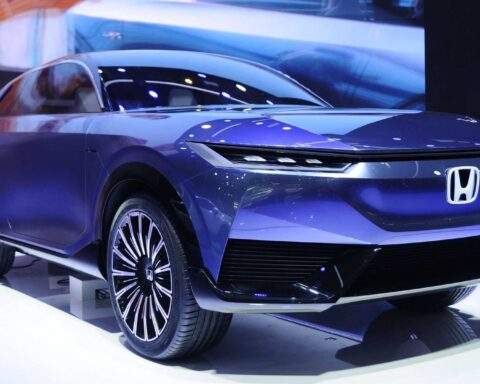Associates at Honda of Canada Mfg. (HCM) celebrated the start of mass production of the all-new 2023 Honda CR-V, the 6th generation of America’s best-selling crossover of the last 25 years. HCM is the global lead plant for CR-V production, which has been built in Canada since 2012. In the coming days, production¹ of the all-new CR-V will follow at the Indiana Auto Plant (IAP) and the East Liberty Auto Plant (ELP) in Ohio.
Next month, production of the Honda CR-V hybrid model will start in Canada, followed by IAP and ELP. Honda will increase production of the hybrid model to 50 percent of CR-V sales, which is a key step in Honda’s overall electrification strategy.
“Becoming the global lead plant for the 2023 Honda CR-V was a big challenge, and I’m proud of our experienced team at Honda of Canada Manufacturing and the level of teamwork we had in North America to create this incredible new product for our customers,” said Clement D’Souza, senior vice president of HCM. “Next up is the CR-V hybrid that is more important than ever to the CR-V lineup and a model we are very excited to deliver to our Canadian customers for the first time.”
The all-new 2023 Honda CR-V debuts with a rugged yet sophisticated design, including two turbocharged trim levels, EX and EX-L and the Sport and Sport Touring trims that will be hybrid-electric powered.

Perfect for daily life or weekend escapes, the new CR-V is longer and wider with premium proportions and a significantly broader stance, further advancing the new Honda design direction with a low horizontal beltline and a long, powerful front end. Honda’s most popular SUV backs up its strong new looks with a more fun-to-drive personality, more confident and refined dynamics, and increased torque and capability. For product details, please click here.
Manufacturing the 2023 Honda CR-V
A year ago, HCM Line 1 served as the lead plant in North America for the production launch of the all-new 2022 Civic. Now, Line 2 at HCM is the global lead plant for CR-V. CR-V production will launch at the Indiana Auto Plant and the East Liberty Auto Plant in Ohio in the coming weeks. All three plants worked closely together to implement new technologies and processes for CR-V to deliver an innovative and consistently high-quality product for Honda’s North American customers.
- HCM employed a “perfect body” fixture for the first time to more quickly achieve optimal fit and finish using a data-driven process. An approach first employed at ELP for the 2017 CR-V new model, this full-size mock-up of the CR-V body is milled from a single piece of steel with the highest dimensional accuracy to help mature the fit of interior parts and components, as well as the tailgate. Time is critical during the trial production stage and, in the past, the team would need to tear apart a trial unit to diagnose fit and finish issues. The perfect fixture enables the team to quickly apply countermeasures on the main assembly line.
- The new CR-V has the largest hood in product history, a key element of the bold styling that fulfills Honda’s rugged direction for the brand’s light truck lineup. To deliver on this hood design in a mass production environment, Honda production engineers worked with the development team to increase rigidity by increasing the thickness of the steel sheet and adjusting the hood frame design so that it could be handled through the stamping and weld departments. The result is a hood that delivers on the bold and sophisticated design direction.
- The new CR-V is also dramatically increasing the use of high-performance structural adhesive for increased body rigidity and is newly applying acoustic spray foam to the body structure for enhanced cabin quietness. While the Indiana and East Liberty plants have applied these materials to other new Honda vehicles, including Civic, Line 2 at HCM is employing these processes for the first time and needed to add new equipment and associate training. The result is a new CR-V with increased dynamic rigidity and a quieter ride.
- With the R&D team in Japan, the initial prototype build for CR-V would typically take place there, but with development taking place during the early stages of the COVID-19 pandemic, travel restrictions were in place. Since the North American production teams could not travel to Japan, the prototype build was moved to HCM where the use of digital tools were applied to collaborate between sites. This activity led to design and process changes that now make it easier for Honda production associates to build CR-V to a high level of quality.
Honda Manufacturing in North America
Honda has produced automobiles in North America for 40 years, beginning in November 1982 at the Marysville Auto Plant. Honda began manufacturing operations in North America in 1979 with motorcycle production in Marysville, Ohio.
Over the past four decades, Honda has steadily grown local production capabilities and now employs more than 30,000 associates at 18 plants with the annual capacity to produce 1.86 million automobiles, nearly 4 million engines, 500,000 power equipment products and 300,000 powersports products, as well as the HondaJet advanced light jet and GE Honda HF120 turbofan engines. In 2021, more than 95% of all U.S.-sold Honda and Acura automobiles were made in North America, using domestic and globally sourced parts.
Cumulatively, Honda has invested nearly $24.6 billion in its North American manufacturing capabilities, including more than $3.6 billion over the past five years alone. The company works with nearly 800 original equipment suppliers in North America with cumulative parts purchases of more than $535 billion.






